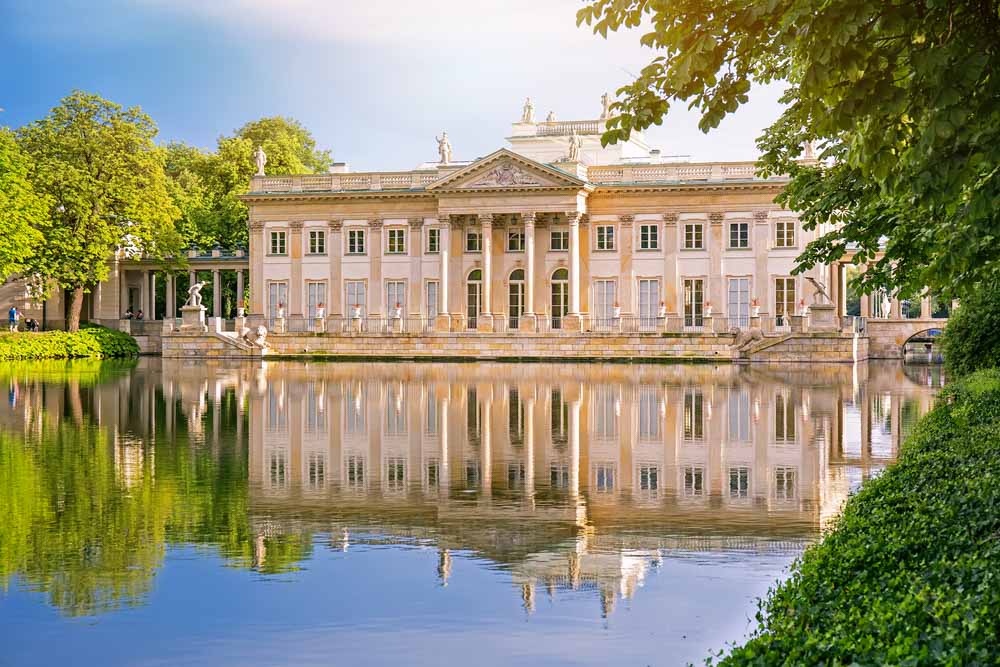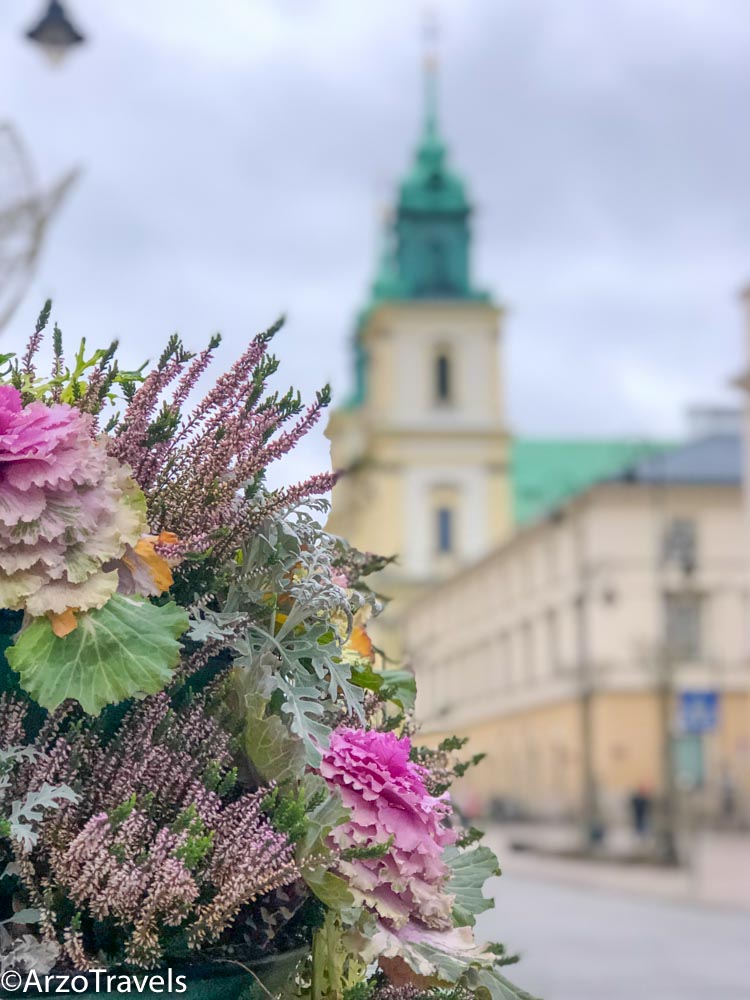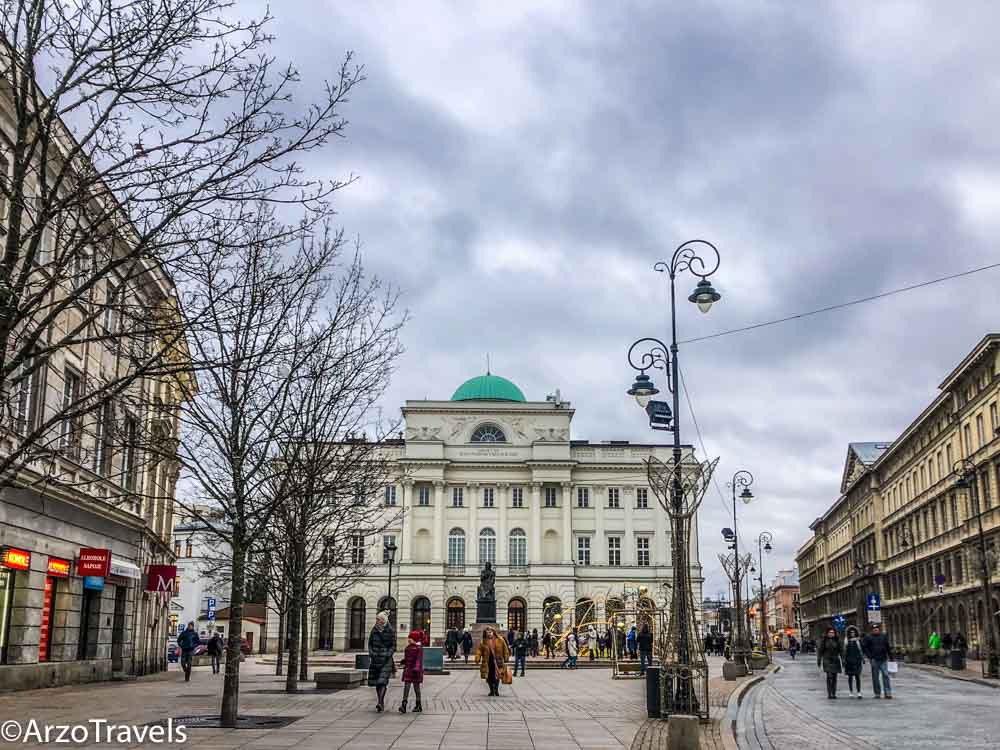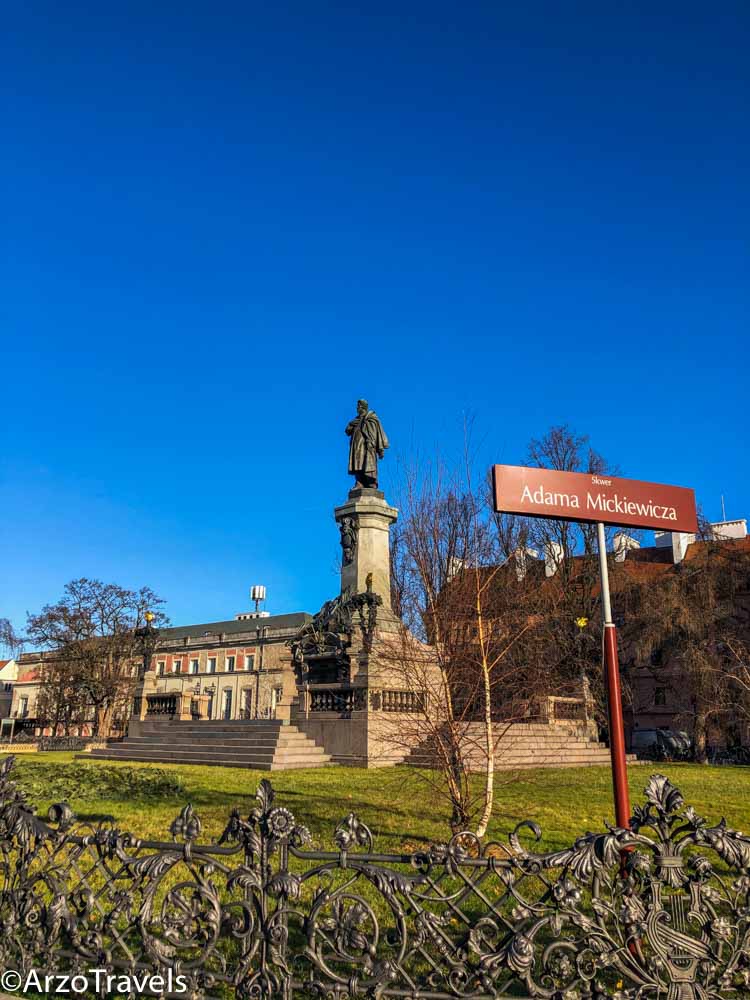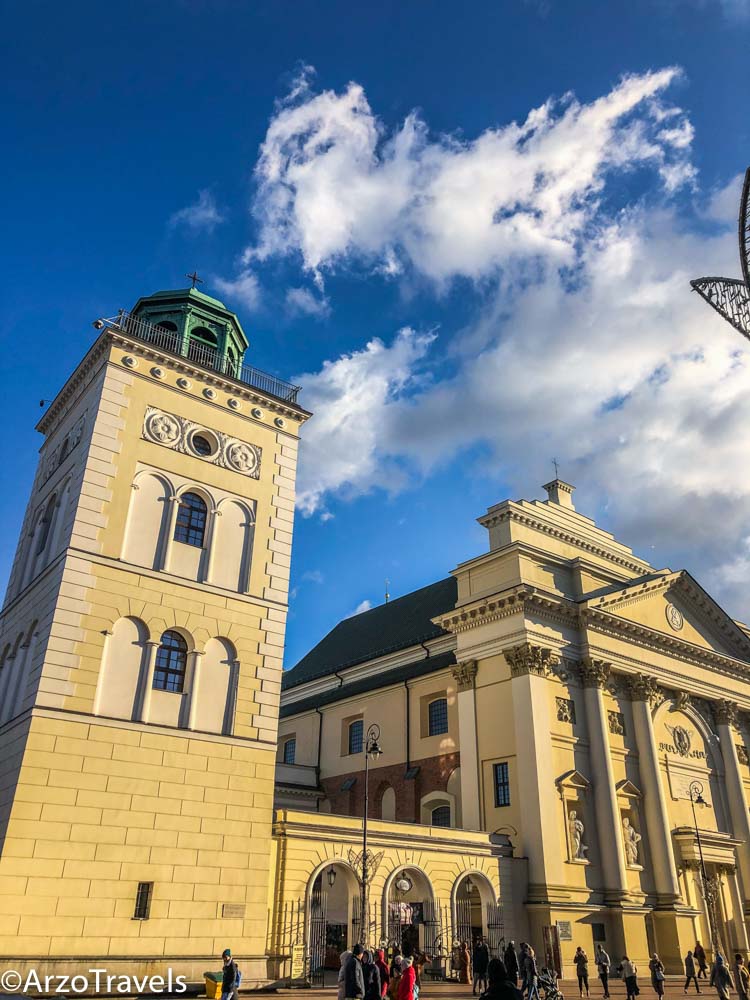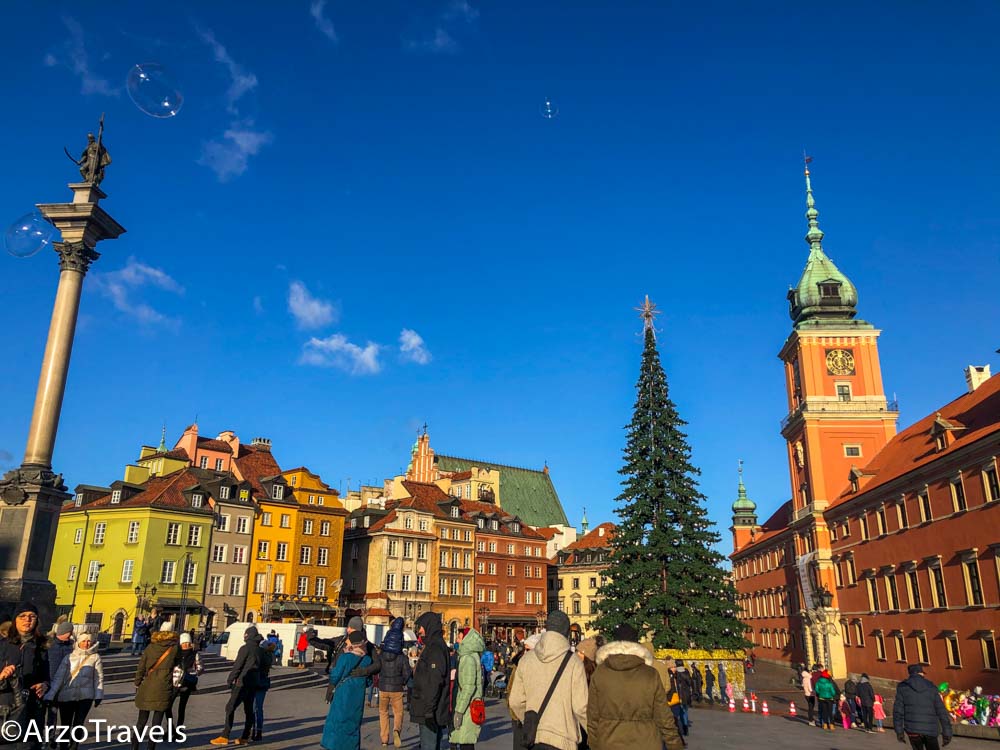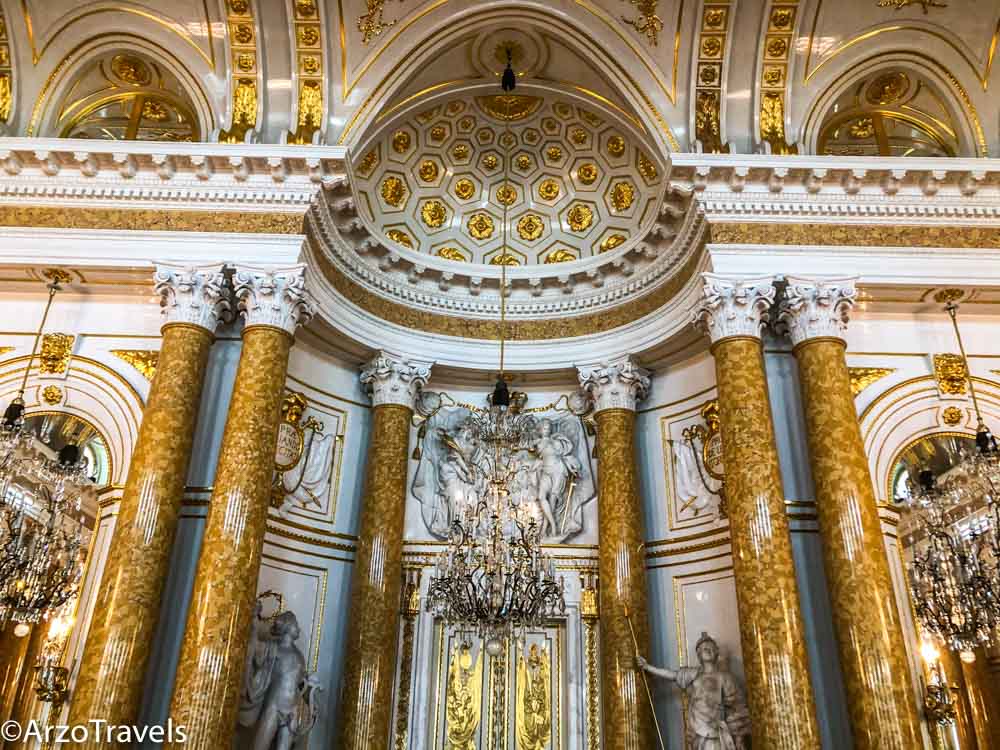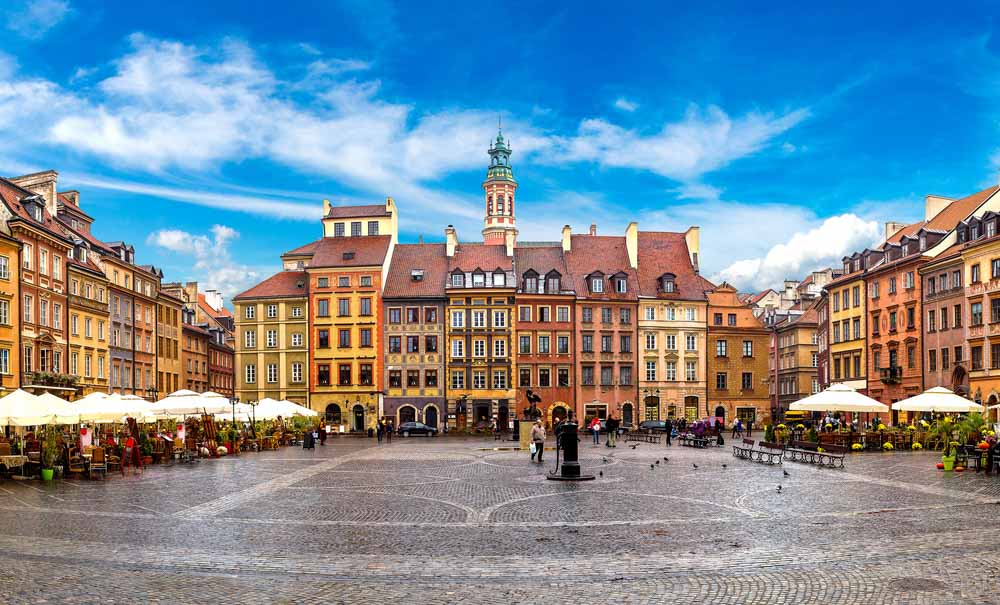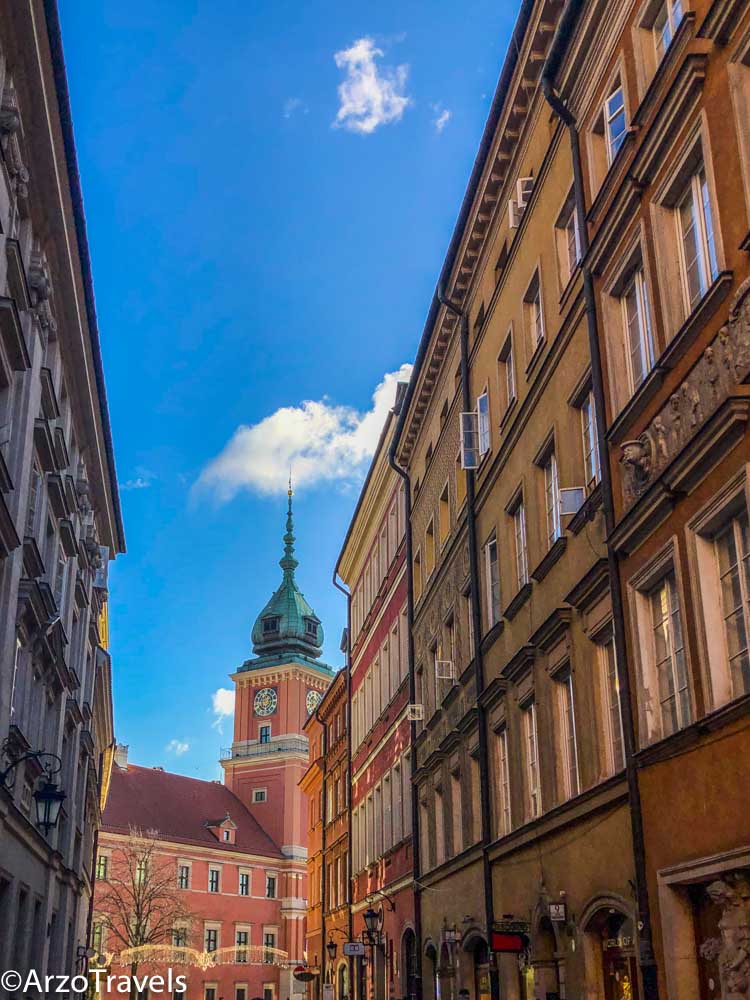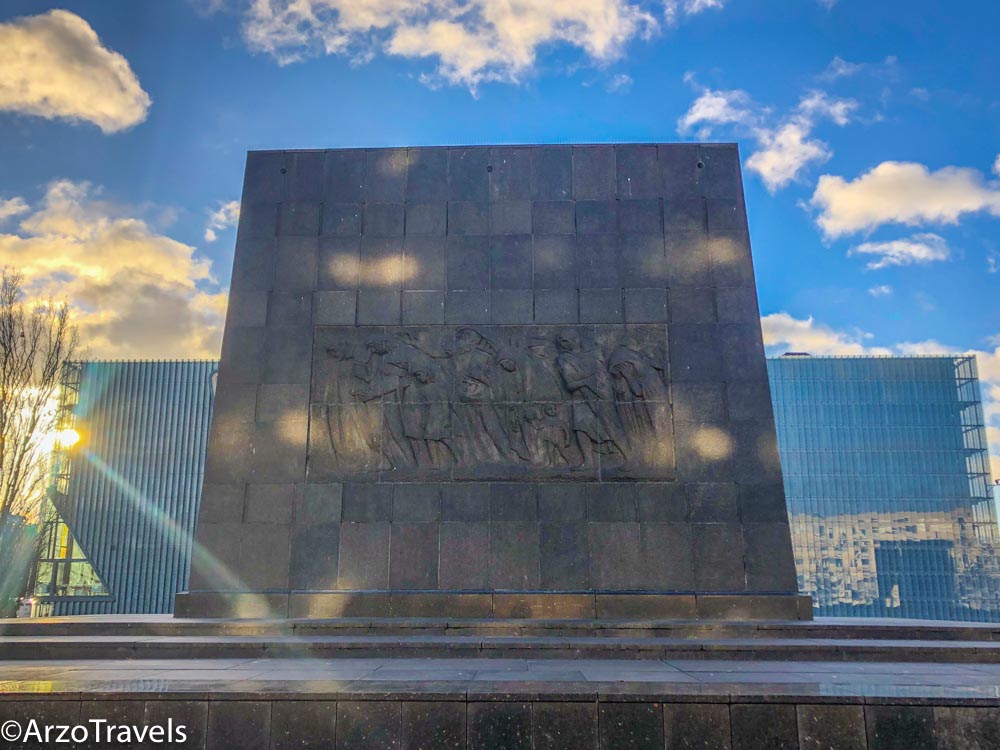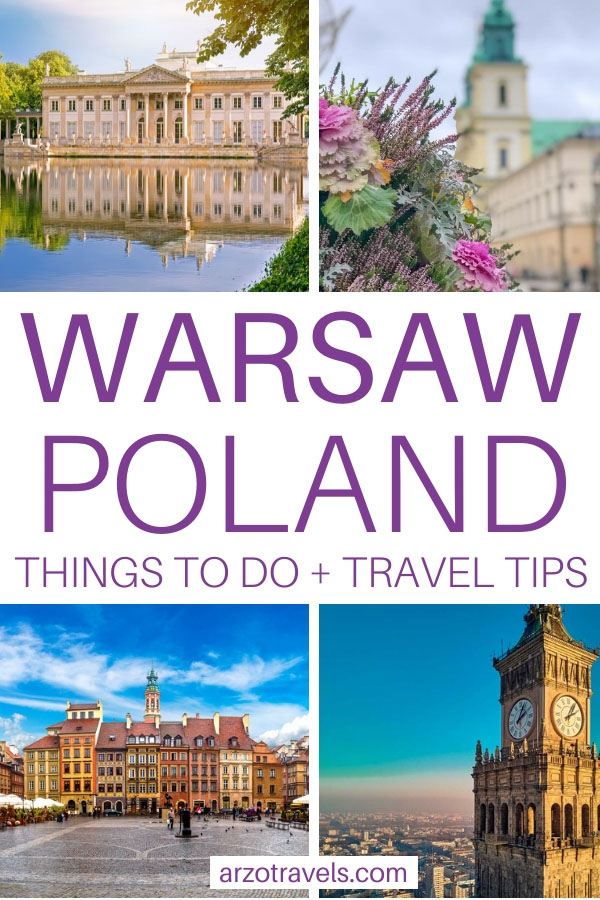BEST PLACES TO VISIT IN WARSAW IN 2 DAYS
Are you planning a 2-day Warsaw itinerary and wondering about the best things to do in 2 days in Warsaw? Then read on as I share my tips for your trip.
“Poland´s capital is an old and ugly city.” I had heard this statement a few times from my Polish friends here in Germany. Truth be told: My friends could not have been more wrong. Warsaw is so different than I expected and exceeded my expectations by far. I have visited a few other Polish cities, like Gdansk and Wroclaw, and each city was beautiful. However, Warsaw offered more museums and has a lovely old town – it is such an underrated city.
Colorful, charming, and lovely with a lot of interesting history, it swept me off my feet right away. Are all areas beautiful in Warsaw? No, of course not. But which city can claim to only consist of pretty neighborhoods?! None. But in the city center, you will be surrounded by many beautiful buildings and a lively city life that makes it charming and lovely.
2-DAY WARSAW ITINERARY
Though this 1-or a 2-day Warsaw itinerary also will lead you out of the city center, you will spend a good amount of time there. You will also find some travel tips for your 2-day Warsaw itinerary at the end of the post. P.S. Check out my Poland itinerary.
Disclaimer: This post contains affiliate links. This means I might earn a small commission when you buy a product/service via my link (at no extra cost to you). More about it here.
DAY 1 OF 2 DAYS IN WARSAW
For the first day in Warsaw, I suggest spending some time outdoors. So, check the weather forecast and swap day 1 with day 2 if the forecast predicts better weather for day 2.
Please keep in mind that many museums/places are closed on bank holidays – even if not specifically mentioned in the opening hours.
Stop 1: Royal Lazienki Museum and Park
Why don’t you start your first day in Warsaw with a relaxing activity? Head to Lazienki Park, where you will also find some main landmarks in the country.
This park is popular among locals and visitors alike. You can enjoy some nice long walks and prepare for Warsaw’s busyness. You will walk in nature and have some beautiful sights and attractions in the park – like the summer residence of the last king of Poland. Here, in the Palace on the Island, King Stanisław August Poniatowski hosted his dinners for scholars and poets to discuss the issues of the day.Today, it is a museum where you can admire paintings from the royal collections. But you will find more places to visit here:
- Palace on the Water
- White Maisonette
- Myslewicki Palace
- Old Orangery and more
In the summer months, even Chopin concerts take place here.
You could take your sandwiches with you and have breakfast here. Or, depending on the length of the visit, you can also have your lunch picnic here.
Opening hours/tickets:
- There are different opening hours for the different places.
- The gardens are open from Monday to Sunday from 5.30 am to 9 pm. Visiting the garden is free.
- You need tickets for different places, like the Palace on the Water. A ticket for all places costs around 9€.
- Apparently, there is no admission on Fridays.
I suggest spending a few hours here (also depending on the weather), but not a full day as there are more beautiful places in Warsaw waiting for you to discover.
Stop 2: Royal Route
From there, you can walk along the Royal Route.
The Royal Route – these days – comprises a series of connecting Warsaw streets that feature several historic landmarks and connects three former residences of Polish rulers: Royal Castle, Royal Łazienki, and Wilanów Palace.It begins at Warsaw’s Castle Square and runs down south – arriving at Wilanów (King Jan III Sobieski’s personal residence).
Along the way, you will come across many, many beautiful buildings. Many of them are of political importance. It really depends on how often you actually stop to visit certain churches or sights. You could probably spend a full day just visiting the sights along the way. You will find the Presidential Palace, the Warsaw University campus, the Holy Cross Church (and more churches), Staszic Palace, statues, townhouses, and more.You don’t have to walk all of the 11-km-long route. You can also take a bus, get closer to the old town, and then get off at/near the old town, or walk the main route only (about 4 km). Personally, just walking Royal Street was one of my highlights in 2 days in Warsaw.
Stop 3: Old Town Observation Tower
When you arrive at Castle Square, you will also find the old town observation tower (bell tower), which apparently offers great views over the city.
You can (or rather have to) climb up about 150 stairs for a small entrance fee. And then you can enjoy the views. However, you have to pay in cash. I was traveling cashless and thus had to pass on this view. This still bugs me as I think the views are worth it (I am all about views).
Opening hours:
- May – October: weekdays from 10 am – 9 pm and weekends from 11 am – 10 pm
- October – May: weekdays from 10 am – 6 pm and weekends from 11 am – 6 pm
- Ticket prices are less than 2€ for adults (discounts available)
- Only cash payment at the ticket counter on the ground floor of the Bell Tower.
Stop 4: Royal Castle and Castle Square
Once you get down from the bell tower, you can continue your journey and discover the beautiful old town with its pretty buildings. Warsaw’s Old Town is just charming. Here you will – finally – be convinced of how colorful the city is.
The next stop should be the Royal Castle – if you can only visit one castle/palace, make it this castle. In Warsaw, the Royal castle – built in the late 16th century – served throughout the centuries as the Polish monarchs’ official residence. It is a UNESCO World Heritage site with a lot of history.
The Royal Castle was seriously damaged during World War II but has been rebuilt and is now open to the public.
The Great Assembly Hall – the biggest room in the castle – is especially stunning. On Castle Square, you will also find the column of King Sigismund III Vasa, who in the 16th century moved the capital of Poland from Krakow to Warsaw.Opening hours/tickets:
- Mondays – closed
- Tuesdays – Sundays from 11 am – 5 pm (last admission one hour before closing time)
- Tickets are around 9€ for adults (discounts available) and can be bought at the ticket center at the Royal Castle
Often, you will find artists here which makes it even more fun to visit.
Stop 5: Old Town and Old Town Square
From Castle Square, head to Old Town Square. It is just a stone‘s throw away and the oldest square in the city, established at the turn of the 13th century.
It’s enclosed by around 40 colorful houses that had to be rebuilt after being reduced to rubble by the Germans at the close of WWII. You have to walk along some cute streets that have some places you might want to stop.
Then, once you arrive at the middle of the square, you will find a statue of the Warsaw Mermaid, the city’s emblem and guardian. And of course, the buildings – which come in many different colors – are very noticeable.
There are a couple of museums, but you can also just get lost in the streets. Don´t worry, even though Warsaw is quite big, the old town isn’t, and you won’t get literally lost. If you are interested in the city’s history, visit the Museum of Warsaw or follow the Old Town Cellars Route.Stop 6: Barbican Fort
Make a little detour to the Barbican Fort, which is behind the old town square.
Though it is not really spectacular, it is lovely to stroll along the old city walls and snap some pics from the observation point at Gnojna Góra. It is free to visit, so you can’t go wrong.You could also pay a visit to the St. John’s Archcathedral, which houses, amongst other things, the tombs of the medieval Masovian princes and the last king of Poland.
- TIP: If you prefer guided tours, where you get a lot of information, check out this guided tour of the old town of Warsaw.
Stop 7: Multimedia Park
So, depending on your speed, it might be late afternoon already. And since this is a busy day, I suggest ending it with a great dinner in the old town or heading to the multimedia park for some entertainment.
Close to the old town is this park that is a great place to watch some light shows. The light show doesn’t take place every night and not all year, but then visit if they are going on. On the water screen with fog scattered over the water, you can watch an animated story about Warsaw’s history and its legends. It is accompanied by laser lights and several meters-high columns of water rising to the rhythm of the music, lit by colorful floodlights.
Depending on the time of the visit, the show changes (free to watch). There are even some winter shows.
- So, make sure to check out the showtimes and add them to your 2-day Warsaw itinerary.
This day in Warsaw is such a fun and colorful day – and includes great views. Day 2 will be completely different – though not less interesting.
2 DAYS IN WARSAW
For day 2 in Warsaw, I suggest learning about the more recent history of Warsaw. Especially about World War II, as Poland was one of the countries most affected by the war.
As you most likely know, World War II was started by Hitler, leader of the Nazi Party in Germany, who invaded Poland on 1 September 1939. His main goal was to make Germany a “world power” and “protect the supposed purity and strength of the Aryan race,” meaning killing Jews and other Non-Aryans. This led to the Holocaust – the genocide of Jews and other Non-Aryans (and mentally or physically disabled people), with more than six million people being killed!
In Warsaw, you will find out a lot about that time and how Poland and the Jews were affected. It is not a fun day. But I think it is important to remember! Plus, the information might be heavy to digest, BUT the museums are well done and make it easy to stay interested!
2 museums will be the focus on this day.
Stop 1: Uprising Museum
Start your day 2 in Warsaw by learning about the war at the Uprising Museum.
This interactive museum tells us more about the Warsaw Uprising in 1944. The museum is a tribute of Warsaw’s residents to those who fought and died to free Poland. It shows the military history of the 63 days of fighting and the civilian population’s everyday lives, but it also tells us more about the post-war communist terror. You can listen to the stories of the insurgents and see original exhibits from the uprising.
In Freedom Park – next to the museum – you will find the Memorial Wall, where nearly 11,000 names of soldiers killed in the Uprising are engraved. There are also insurgent murals by well-known Polish artists on the “Wall of Art.”
Opening hours/tickets for Uprising Museum:
- Monday, Wednesday, Thursday, and Sunday: 10.00 am – 6.00 pm
- Closed on Tuesday, Friday, and Saturday
- Tickets are around 6€ (discounts available)
Stop 2: Warsaw Ghetto
From the Uprising Museum, head to the Warsaw Ghetto (either walk the 2km or take a bus).
Poland had a large community of Jews, and the Warsaw Ghetto was the largest of all the Jewish ghettos in German-occupied Europe during World War II.The German authorities established it in November 1940. It meant that all Jewish residents of Warsaw had to move into that designated area. The ghetto was enclosed by a wall over 10 feet high, topped with barbed wire, and closely guarded to prevent movement between the ghetto and the rest of Warsaw.
The population of the ghetto was estimated to be over 400,000 Jews. Living conditions were bad, and in 1942, German SS and police units carried out mass deportations from the Warsaw ghetto.
Opening hours/tickets:
- Free to visit
- Open 24/7
Stop 3: POLIN Museum of the History of Polish Jews
One of the best museums to visit in Warsaw is the POLIN Museum of the History of Polish Jews, located in the Warsaw Ghetto.
It doesn’t only cover the history of Jews in Poland during World War II. It goes back to the first Jewish settlers in Poland one thousand years ago. The museum is divided into several parts. All of them are well-made and make it interesting to watch and learn. Of course, a large part of the museum is about the Holocaust and how, especially, Jews were victims of the war.Though it is a lot of information and somewhat heavy to take in, it is made so well that even younger people can visit and learn a lot.
The whole exhibition should take about 2 hours. If you need a break, you can take it (and re-enter with your ticket) and have a drink or snack at the cafe in the museum.
Opening hours/tickets:
- Monday, Wednesday, Thursday, Friday, and Sunday open from 10 am to 6 pm (last entry to the temporary exhibition: 5:30 pm, last entry to the core exhibition: 5 pm)
- Saturday from 10 am to 8 pm (last entry to the temporary exhibition: 7:30 pm, last entry to the core exhibition: 7 pm)
- Closed on Tuesdays and 3. June, 16 September, 1 November, and 24, 25, and 31 December
- Ticket prices are around 12€ for adults (discounts available)
- On Thursday, admission to the core and temporary exhibitions is free of charge
For day 2 in Warsaw, and after all the history, I recommend ending your day with something fun. Maybe you want to visit a Chopin museum and see a Chopin concert?
Stop 4: Chopin Museum
Why Chopin? Well, he is probably one of the most famous Polish guys and is Warsaw´s pride. Though he wasn’t born here, he lived here for a long time. You will have daily Chopin concerts to visit (for free if you have a Warsaw Card). If you do not have a Warsaw Card, check out ticket prices here.
The Chopin Museum, within the Baroque Ostrogski Palace, displays the work of the famous composer Chopin. I haven’t visited myself, but there are many different ways to learn about him and his music in the museum, and thus, it has become one of Warsaw’s main attractions.
I mean, even the airport is named after him, so a museum seems only logical.
Opening hours/tickets:
- Tuesday to Sunday from 11.00 am – 7.00 pm (ticket sales until 6.15 pm)
- Closed on Mondays, and some bank holidays
- Tickets are around 5 € (discounts available)
- Free admission: Wednesdays
TRAVEL TIPS FOR 2 DAYS IN WARSAW
If you stay in Warsaw for 2 days, these tips will hopefully help you plan your trip.
How to Arrive in Warsaw
Warsaw has an international airport that is well-connected to the city center.
- You can take a bus from the airport to the city center for around 1€.
- The buses run frequently and also late at night and early in the morning.
If you arrive at the main train station, you are within walking distance of the old town.
- You could also take a bus/tram if you don’t stay in the city center.
How to Get Around
You can mostly walk to many sights and won’t need public transportation often.
- While Warsaw is quite big, it is very walkable. Wear comfy shoes because this itinerary will take you through some cobbled-stoned streets.
- However, you might want to take public transportation if you visit the museums or don’t want to walk more than 10km a day.
- Trains and buses are terrific – reliable and affordable. You can buy your ticket at the ticket machines at the bus stations (you can select English as the language, which is very straightforward). However, the tickets are based on the time and zones. You need to think about where you want to go and how long your ticket should be valid. Also, credit cards are accepted (in Europe, American Express – unfortunately – is not as widely accepted as Visa or MasterCard).
Where to Stay
I highly suggest staying in the city center. If you are traveling to Poland from the US or western or northern Europe, you will find that accommodation prices are very reasonable, so staying in the city center should not break the bank.
- I stayed in a hostel in Warsaw and the hostel I stayed in was a great choice. Though not directly located in the old town, it was still nicely located, and the value for money was great. Check out rates here.
However, since prices in Warsaw are not as high as in other European capitals, you also get quite good value for money if you book a mid-range or luxury accommodation. Check out InterContinental for a luxury hotel.
Is Warsaw Safe For Solo Female Travelers For 2 Days?
I traveled to Warsaw by myself and felt safe.
- I strolled the city center after sunset and did not feel scared in any way – however, I always exercise common sense.
- Avoid side streets at night and probably dodgy areas, especially in the evening. However, with 2 days in Warsaw, I did not come across any dodgy neighborhoods.
- Watch your belongings and keep your valuables with you.
Language in Warsaw
I found quite a lot of people who spoke English well enough. I did not have any issues, and many also spoke some (basic) German. When I visited Poland the first time – like 12 years ago – that was completely different. But with English, you are good to go.
Warsaw Card for 48 Hours
I did not get a Warsaw Card, but it might make sense for you. If you visit a Chopin concert, you can watch it without extra costs and do a few other activities. It might help you save money. For me, it did not pay off, especially because the entry to the Royal Palace isn’t included.
More Tips For your 2-Day Warsaw Trip
- Have some cash on you, as credit cards might not be accepted in smaller shops/attractions.
- The currency is the Polish zloty – 1 zloty is about 0,22€.
- Wear comfy shoes. Warsaw is made for walking.
- Check out my guide for what to pack for Europe in the summer
- Here is my winter packing list for Europe
CONCLUSION: WHAT TO DO IN 2 DAYS IN WARSAW
Warsaw, the capital of Poland, is a vibrant city blending rich history with modernity. Its resilient spirit reflects the reconstruction post-World War II. 2 days in Warsaw allows you to explore historic landmarks like the Royal Castle and Wilanów Palace, alongside contemporary attractions.
So, hopefully, these tips will help you while planning your Warsaw itinerary – now filled with information on the best places to visit and top things to do in 1 day or 2 days in Warsaw. If you want to find out more about beautiful Polish cities, check out my Gdansk itinerary.
2 DAYS IN WARSAW ITINERARY – PIN ME FOR LATER
Save this pin on Pinterest for your trip!

